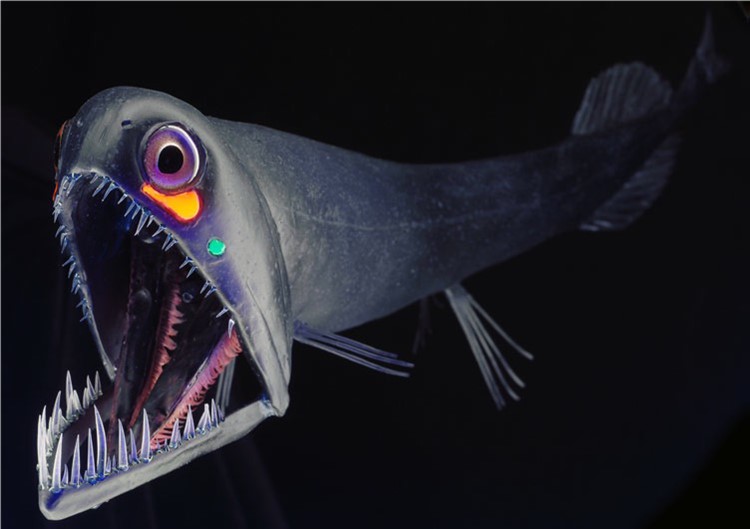
Credit: ESRI, Dr. Beinart, Tracey T. Sutton, CC BY-SA 4.0, via Wikimedia Commons
99% of Earth’s biomass is estimated to be on land, with only 1% in the oceans.
However, Earth’s biomass is mostly plants. And the average terrestrial plant is huge—a 2-ton tree that could live for a century. Whereas the average marine plant is tiny—a single-celled organism that might live just a few weeks.
That said, about three-quarters of animals, by biomass, live in the sea. That’s because the oceans are incredibly rich with tiny shrimp-like creatures. Antarctic krill alone make up almost 400 million tons of biomass.
But what’s really amazing about life in the ocean is how much we don’t know.
Scientists recently estimated that there are almost 9 million species of plants and animals on Earth. About 2.2 million of those are in the oceans—but only 10% of those are cataloged.
That’s right: by these recent estimates, over 90% of ocean species are unknown to science.
This correlates well with seafloor samples brought up from the deep. In them, about 90% of the species we find were previously unknown.
That may be about to change. The UN has declared the 2020s the Decade of Ocean Science. There are many projects underway to catalog species and map the ocean floor.
But with 2 million species yet to discover, it could take a thousand years to catalog them all …
Which makes it a very exciting new frontier for scientists.
Background
Synopsis: Earth’s oceans cover 71% of our “Blue Planet,” providing about 99% of its habitable volume. Life originated in the sea, but today just 15.6% of Earth’s known species live in the sea, representing only 1% of Earth’s total living biomass. Recent estimates suggest 91% of ocean species have yet to be cataloged, and some may go extinct in the decades it will take to find and describe them.
- Earth’s oceans are vast, covering 71% of the planet’s surface. About 99% of Earth’s habitable space is in the oceans.
- The volume of water in the oceans (321 million mi3 [1.34 billion km3]) would cover Earth’s current land area (58 million mi2 [150 million km2]) with water 5.5 mi (9 km) deep.
- Most terrestrial species live within 100 ft (30 m) of Earth’s surface, so much more habitable volume is available for oceanic species than for land-based species.
We can think about quantifying life in the oceans in three ways: by individual animals, by species and by biomass.
- It is impossible to count all the individual life-forms in the sea, or on the planet.
- If you think about the 39 trillion microbes in your own microbiome—that’s 39,000,000,000,000 individual life-forms in every person’s gut—it becomes obvious that attempting to count the number of individual multicellular life-forms would be astounding and imprecise.
- Now imagine that every aquatic multicellular life-form hosts its own microbiome. The math becomes mind-boggling. So, let’s not try to count individual organisms.
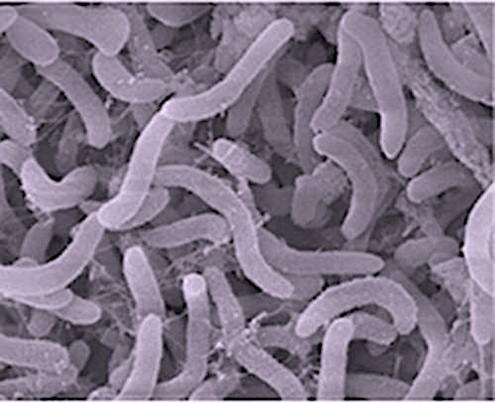
Microscopic photo of the bacterium Pelagibacter ubique, the most common bacterium in the ocean and possibly the most common in the world.
Credit: Gulf of Alaska Seamounts 2019 Expedition, public domain, via Wikimedia Commons
- One way to count life is at the species level, illustrating diversity. We can consider both existing cataloged species and predictions about species we have yet to discover.
- In 1758 Swedish biologist Carl Linnaeus developed a comprehensive system of taxonomy that classifies the diversity of nature hierarchically, from kingdom to phylum to class to order to family to genus and, finally, species.
- Species is the smallest subdivision that describes a group of organisms that can interbreed to produce fertile offspring.
- In the 265 years since Linnaeus developed his taxonomic scheme, just over 1.24 million species have been cataloged, and only 194,400 of those, just 15.6%, are marine species. These values change as biologists continue adding species to the catalog.
- In the past, scientists guessed that between 3 and 100 million species might exist on Earth, but in 2018 researchers completed an extensive statistical study estimating that the total number of species on Earth is closer to 8.75 million (give or take 15%), with 25% of those in the oceans, for about 2.21 million oceanic species.
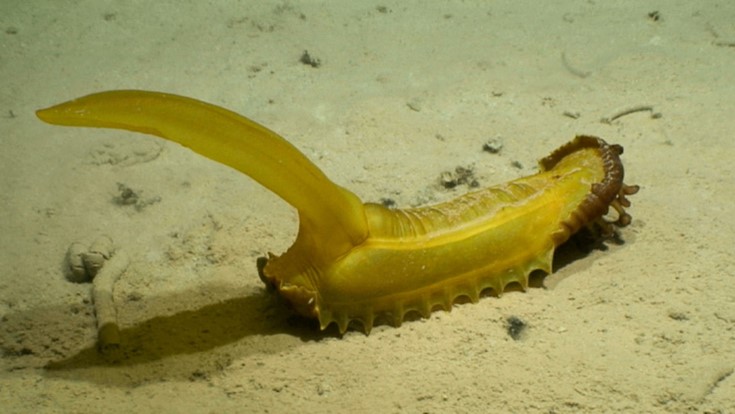
This unusual gelatinous animal is a new species of sea cucumber (Psychropotes longicauda) found in 2022 on abyssal sediments at a depth of 16,732 ft (5,100 m) in the western Clarion-Clipperton Zone (located between Hawaiʻi and Mexico). This animal is about 2 ft (60 cm) long (including tail), with red feeding palps (or “lips”) visibly extended from its front end (right).
Credit: The DeepCCZ expedition, via NOAA Ocean Explorer - That means 91% of ocean species (around 2 million) have yet to be discovered, identified, and cataloged. For Earth as a whole, it is 86% (7.5 million) of species we have yet to find.
- This makes sense because undiscovered species are so common in deep-sea sediment surveys, often accounting for upward of 90% of samples.
- Biologists have their work cut out for them: at current rates of identification and classification it could take as long as 1,000 years to complete the catalog.
- Unfortunately, these huge numbers mean some species living today will go extinct before we even know they existed.
- Why is biodiversity so much greater on land than in the sea?
- Distribution of life on land is much different from that of life in the sea. The oceans are a more stable environment through time for life than the tumultuous land surface of Earth, so there are fewer adaptation pressures for aquatic life.
- Plants are primary producers on land and are the dominant life-form from both a species (25x) and biomass (95%) perspective.
- This is due to the enormous contribution of supportive woody tissues that support trees as they stretch skyward in competition for light energy.
- Plants get nutrients from soil, so they must stretch out roots to find them.
- Terrestrial habitats are more fragmented and diverse, requiring greater adaptation and species differentiation.
- The evolution of flowering plants on land tipped the scales 125 million years ago, favoring variety of terrestrial life-forms over those in the ocean.
- Primary producers are distributed almost evenly across several kingdoms in the oceans, representing about 20% of total biomass.
- In the ocean, organisms can adjust their buoyancy to float closer to the light or build smaller bodies that sink slowly and are more efficient at absorbing nutrients by diffusion from seawater.
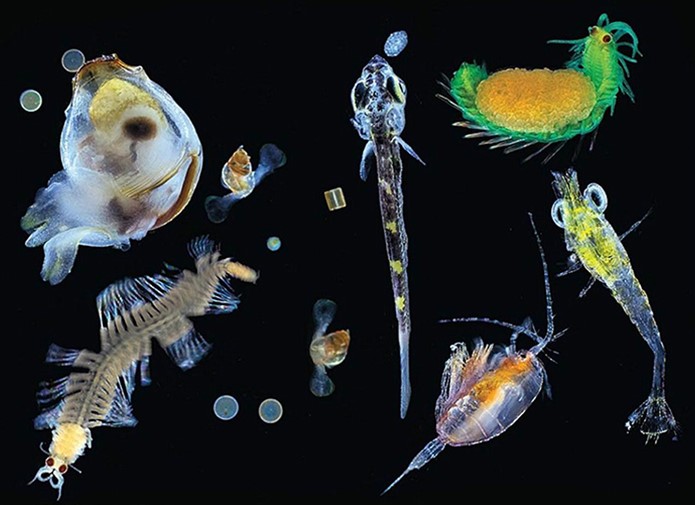
A diverse assemblage of unicellular and multicellular oceanic organisms with different sizes, morphologies, feeding strategies, ecological functions, life cycle characteristics, and environmental sensitivities.
Credit: Christian Sardet/CNRS/Tara expeditions, CC BY 4.0, via Wikimedia Commons - The ocean is a large, interconnected habitat lacking temperature extremes, so it is less likely to drive diversification.
- Producers in the ocean live and die fast, replacing themselves at a rate that enables the oceans to match primary production on land with a much smaller living biomass.
- In the ocean, organisms can adjust their buoyancy to float closer to the light or build smaller bodies that sink slowly and are more efficient at absorbing nutrients by diffusion from seawater.
- Another way to measure life is to quantify biomass—the mass of organic material measured in metric tons of carbon—because all living things are made of carbon compounds. One gigaton (Gt) of biomass is a billion metric tons.
- Just 1% of Earth’s total biomass lives in the oceans.
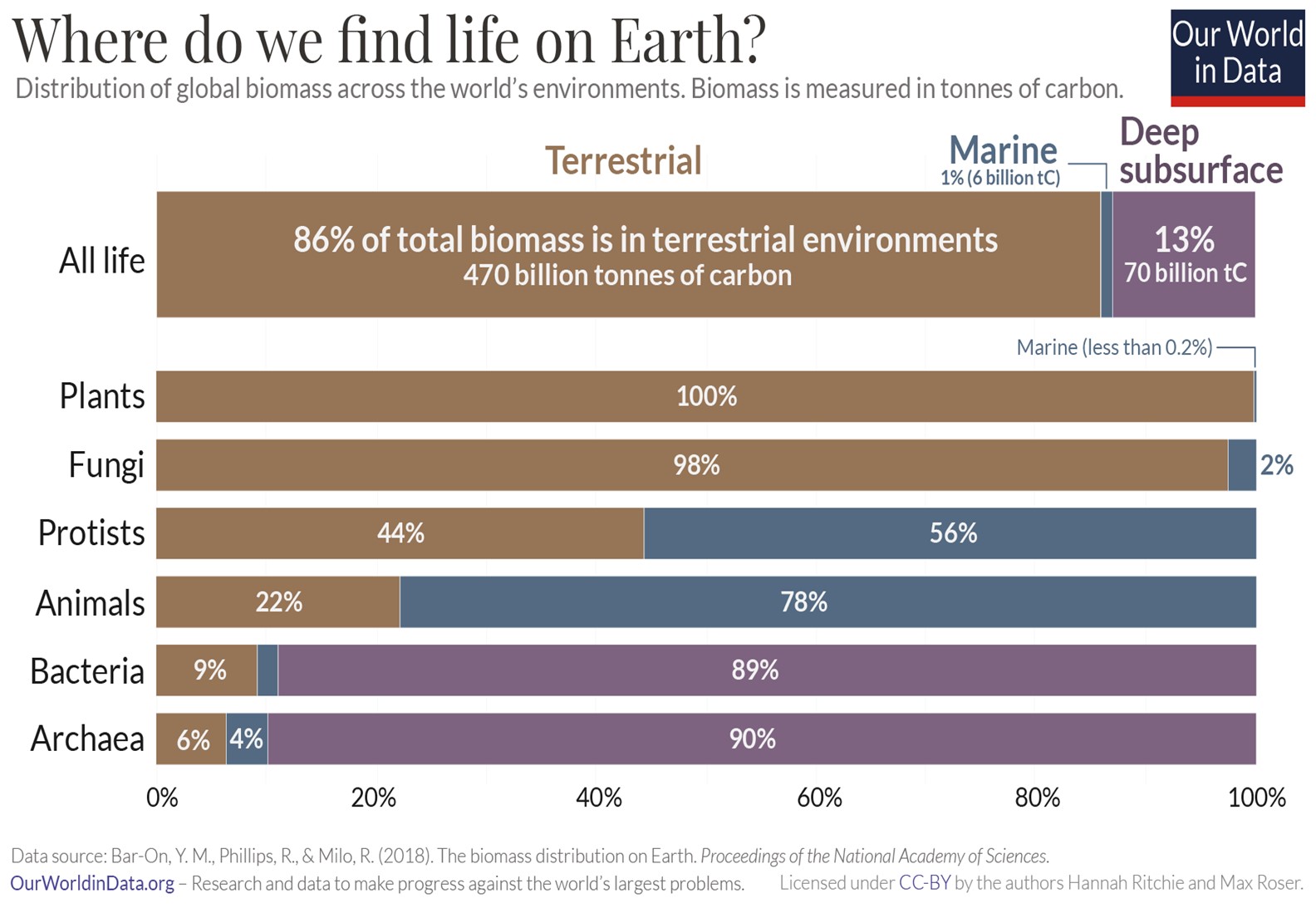
Global biomass is distributed with 86% on land, only 1% in the oceans and 13% in the deep subsurface (26 ft [8 m] or more underground).
Credit: Hannah Ritchie and Max Roser, licensed under unspecified CC-BY version, via Our World in Data. - Plants represent 82.4% of Earth’s total living biomass, and only 0.2% of plants are aquatic. The average land plant is a 2-ton tree that lives for decades to centuries. The typical aquatic plant is a single-celled organism that lives 20 days.
- About 78% of animal biomass is marine. Despite their relatively small size, mesopelagic copepods, shrimp and krill dominate marine animal biomass by sheer numbers.
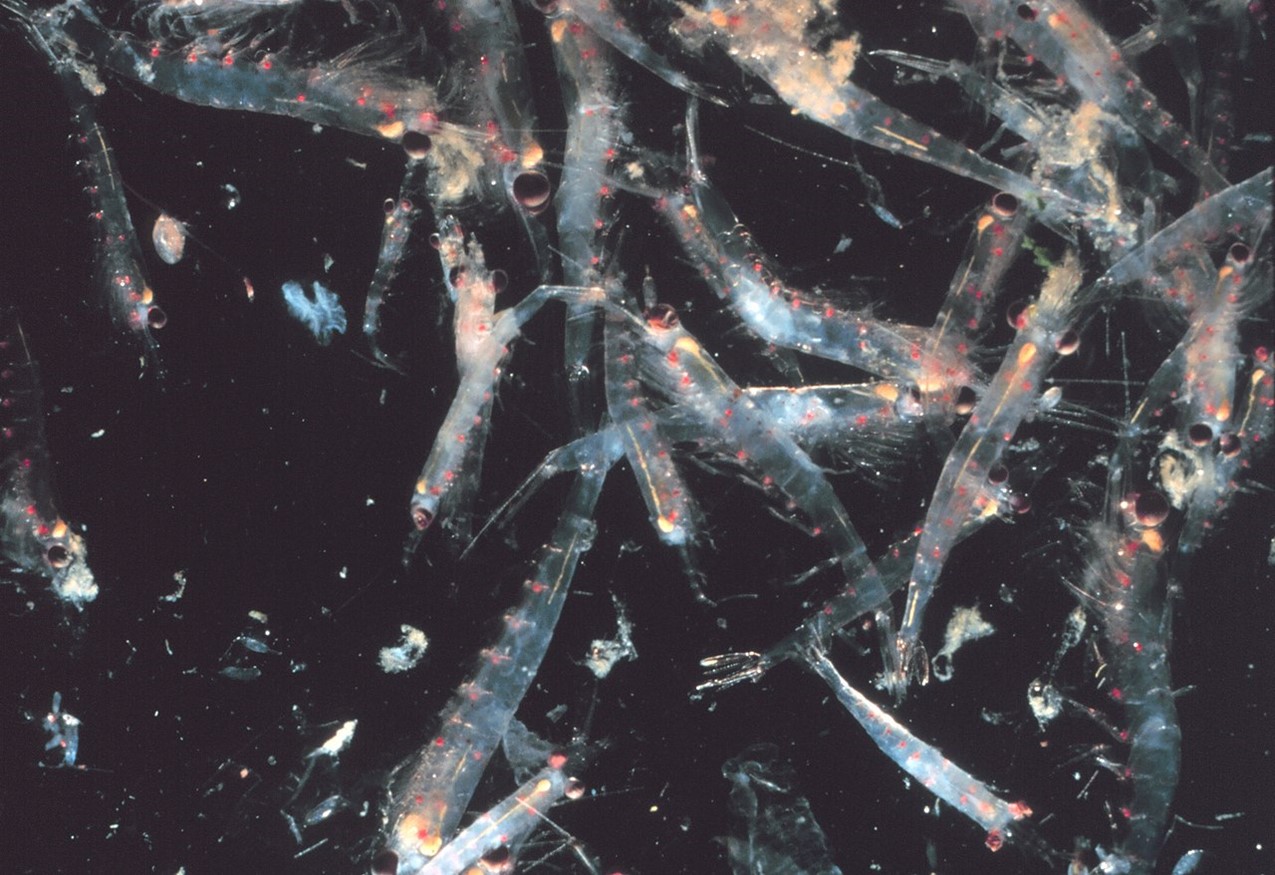
Krill are small crustaceans of the order Euphausiacea and are found in all the world's oceans, occupying a position near the bottom of the food chain. They feed mainly on phytoplankton and are prey for larger marine animals. In the Southern Ocean, one species, the Antarctic krill (Euphausia superba), makes up an estimated biomass of around 379 million tons, placing it among the top species for largest total biomass. Most krill species display large daily vertical migrations, thus providing food for predators near the surface at night and in deeper waters during the day.
Credit: Jamie Hall, public domain, via Wikimedia Commons - 56% of protist biomass is marine, largely being plankton at the base of the food chain.
- Single-celled organisms account for two-thirds of marine biomass.
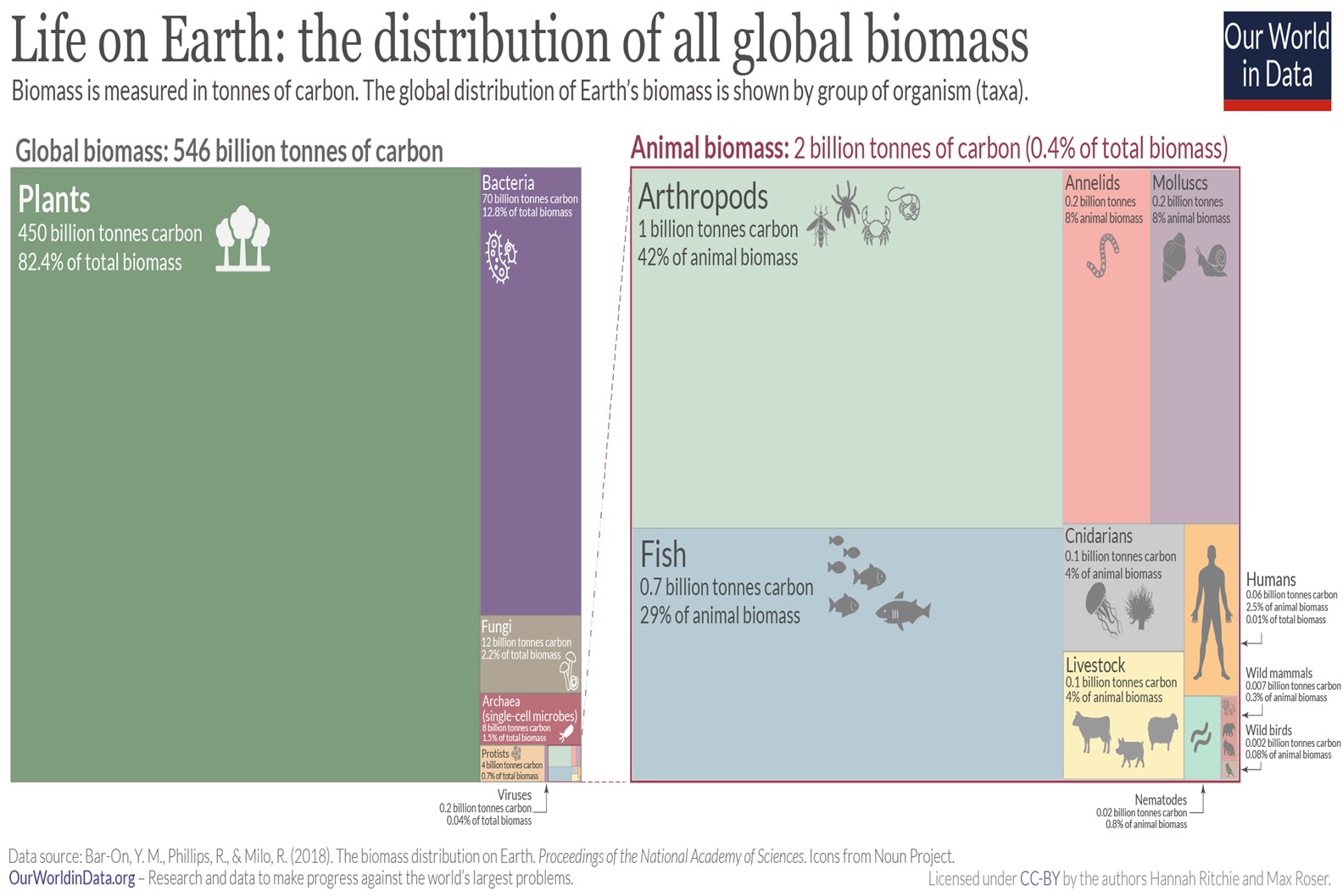
Left: Global biomass in gigatons. Just 1% of this biomass is marine, while humans are just 0.01% of Earth’s biomass (ED-252 Biomass Census).
Right: Detail of the 2 Gt of global animal biomass, 78% of which lives in the ocean.
Credit: Hannah Ritchie and Max Roser, licensed under unspecified CC-BY version, via Our World In Data
- Just 1% of Earth’s total biomass lives in the oceans.
- The 2020s are the UN Decade of Ocean Science, so scientists are especially focused on enigmas of the seas. Get set for many oceanic discoveries!
- The Seabed 2030 project will fill the gap in seafloor bathymetry by mapping 100% of the ocean floor at resolutions ranging from 328 to 2,624 ft2 (100–800 m2), depending on water depth.
- See the 2000–2010 Census of Marine Life coordinated by Jesse Ausubel.

